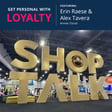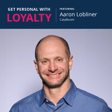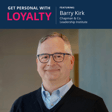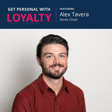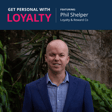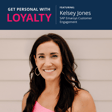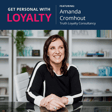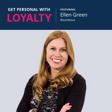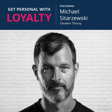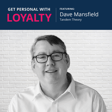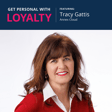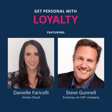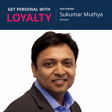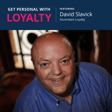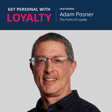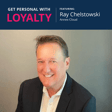Become a Creator today!Start creating today - Share your story with the world!
Start for free
00:00:00
00:00:01

Leveraging the Value of Partnerships to Enhance Customer Loyalty (ft. Chuck Ehredt)
In this episode, we speak with Charles (Chuck) Ehredt, is the co-founder and CEO of Currency Alliance, based in Barcelona, Spain. With several hundred clients spread around the world, Currency Alliance operates a pure B2B technology platform that is like a payment network processing loyalty transactions between partners. Tune in to learn some eye-opening insights on how customers can earn, redeem, or exchange points/miles with greater freedom and choice.
Transcript
Introduction & Guest Background
00:00:10
Speaker
Get personal with loyalty, where we're discussing using loyalty to deliver personalized, relevant customer experiences. Hello, everybody, and welcome to today's podcast. Today, I'm here with Chuck Aret, the CEO of Currency Alliance. Hi, Chuck. Well, good afternoon or good morning. It depends on where people are, but I'm flattered to be here. Thank you.
00:00:34
Speaker
So excited to have you. This is going to be a fun conversation today. Let's get started with you giving us a little bit of your background. I know that I've known you now for a while, but it didn't really know how you got started in loyalty, and you haven't been one of us that's been here forever. That's for sure. Well, that's true. I mean, I've been joining loyalty programs probably for 35 years. And when I used to work for Accenture quite a long time ago, I was traveling like a maniac.
00:01:03
Speaker
I accumulated a lot of points and always had tier status, but I never spent any time thinking about how they operate, the economics of a loyalty program, let alone how each one tries to position itself to deliver value to customers.
Chuck's Entrepreneurial Journey
00:01:19
Speaker
But let me go off on a little bit of a tangent because I actually think it's related to one of our discussion topics today, which is the importance of data.
00:01:27
Speaker
And I'm an entrepreneur by nature. Currency Alliance is the 12th company that I've created in 35 years.
00:01:35
Speaker
And I've also invested in 28 or 29 companies as a business angel investor because I love solving business problems by applying new business models or innovative technology. And about 15 years ago, I was working on an investment thesis related to mobile wallets because I just felt like the way we're going to pay for things in the future is going to be with our mobile phone.
00:02:00
Speaker
And I was fascinated by payments and the ability to use a mobile phone for payments because if you can help a customer spend money four, six, eight, or 10 times a day, you know exactly where they're shopping at what time of day. You may not know what's in the shopping basket, but you're capturing really insightful data based on the customer's actual behavior.
00:02:25
Speaker
So I was very interested in either launching a mobile wallet company or investing in one. And I never did in the end. But I felt like if you could capture all this spending data about customers, you'd be able to build really rich profiles based on actual behavior. And that would improve personalization and targeting.
00:02:46
Speaker
I never traded that company or invested in one because I felt like I'd end up competing with Google and Amazon and Apple, obviously, and all the big banks. Even if I ended up with 10 million customers using my mobile wallet, I might know those 10 million people quite intimately, but I wouldn't know anything about the other 7 billion people on the planet.
Challenges in Coalition Loyalty Programs
00:03:10
Speaker
And anyway, so I just never invested. But then about eight years ago, I was doing some freelance consulting work for a company called AMIA, A-I-M-I-A, which has now been merged into a company called Cognitive. And I think you have some history there. Anyway, at that time, I didn't know much about loyalty, but I
00:03:31
Speaker
Was kind of an expert on travel product distribution and so I was helping them with aeroplane in Canada nectar in the UK and travel club here in Spain. Basically had travel products into the redemption catalog because people who collect a lot of points like to redeem for aspirational travel experiences.
00:03:52
Speaker
And while I was working with them, I started to realize how difficult it was to add more partners into their coalition loyalty program. But they were very motivated to add more partners because they wanted more data about customer spending activity. And I remember walking out of a meeting. It was actually on my birthday in October 2015.
00:04:14
Speaker
And I walked across the street into a restaurant.
The Concept of Currency Alliance
00:04:18
Speaker
I got a beer and a couple of napkins and I just started drawing business models of what would the future of loyalty look like if there were more open collaborative loyalty networks as opposed to these highly controlled coalition loyalty programs. And what really struck me was, you know,
00:04:41
Speaker
If I'm able to process the loyalty transaction for many of the mobile wallets, I could capture the same data as if I was a global loyal mobile wallet provider. But nobody really cared about processing loyalty transactions, so I thought.
00:04:58
Speaker
there's a huge opportunity to become the payment network for loyalty transactions and then be able to help our clients build these really rich customer profiles. So that's what intrigued me. And then, you know, within three or four months we founded Currency Alliance, which is the company that I'm co-founder of and CEO. And yeah, we've been having a really good time for the last seven, seven and a half years in the industry. So that might be more than a two minute introduction, but that's kind of how I got into the industry.
00:05:29
Speaker
Oh, I love it. I love especially the napkin plan. I would like to dig into this coalition versus the open aspect of the partnerships that you're doing is I think there's a lot here for people to understand that may not be super apparent by just saying it and coalitions. Typically, you did say this are highly controlled are the words you used and
00:05:57
Speaker
It's true. And the coalition owner is the one that owns the data versus the brands that participate in those. Correct.
00:06:08
Speaker
Yeah, in fact, I really believe the coalition model is the winning model in the long term, but not based on the way coalitions have been deployed for the last 20 years.
Benefits of Open Loyalty Networks
00:06:19
Speaker
And so almost all the coalitions in the world, whether they're managed by, well, they would have been managed by Amy at one time or American Express or
00:06:27
Speaker
air miles or someone else but basically there was a technology and marketing partner at the center and they were operating the program and then they were inviting large brands to collaborate.
00:06:42
Speaker
The biggest hurdles or friction I think they had in onboarding new partners were a lot of these other big brands did not want to abdicate responsibility for a single loyalty currency to someone else. And they didn't really want a third party to be owning all of their data, let alone whatever cost or fees were being paid. In the end, these coalition models were quite successful for 15 or 20 years. But I believe that based on modern technology,
00:07:12
Speaker
And the economics in the industry in general, you cannot have one party that is capturing all the data, controls the loyalty currency, and then the member brands are kind of like slaves to the coalition operator.
00:07:28
Speaker
This multi-partner collaboration I think is crucial to the success of any loyalty program because most consumers just don't spend that much money with any one brand. If a brand is only operating their own loyalty program with their own loyalty currency, maybe 15% or 20% of their total customers are active enough.
00:07:49
Speaker
to earn enough points to get interesting rewards but the other seventy five or eighty percent of customers just can't spend that much money with a brand to ever get interesting rewards and so if the customer can earn more points or miles among partners. Or possibly redeem points among partners then.
00:08:12
Speaker
The value proposition just doesn't resonate with the majority of customers. And I don't think you can compete this decade or arguably even in the last 10 years against Amazon and Baidu and WeChat and these other companies, unless you know 60, 70, even 80% of your customers.
Data Collection and GDPR
00:08:32
Speaker
And so if you don't collaborate in a more open loyalty network with a bunch of partners,
00:08:40
Speaker
then 60 or 80% of your customers are just never gonna opt in to your loyalty program, and then you're not gonna be able to collect data on them. Under GDPR and similar legislation, you won't even have permission to collect their data or analyze it or send them marketing messages. And so my view is that the cost of the points is trivial compared with the value of the data that can be captured from your customers and then used
00:09:07
Speaker
you know, to drive more engagement with the customer. And so anyway, I just think the standalone loyalty model isn't very effective because it only allows you to be relevant to 15 or 20, 25% of your customers. But the coalition model with the expensive intermediary
00:09:27
Speaker
sucks too much of the value out of the ecosystem. Currency Alliance was created to provide this very thin layer of technology that allows brands to connect with each other and collaborate under whatever commercial terms they want. You could have five partners that all have their own loyalty program and their own points collaborating where
00:09:51
Speaker
the customer could choose which of the points they want to earn among each of the partners, or they could exchange points between the program.
Industry Applications of Collaborative Loyalty
00:10:00
Speaker
But every time a touchpoint takes place or a transaction takes place, it generates insightful data about the customer to help each of the partners improve their personalization and engagement. So like I said a moment ago, I think the cost of the points is trivial. Let the customer choose the points that they want to collect,
00:10:21
Speaker
and focus on the value of the data and then driving more customer engagement. But the only way this really works is if there's very low cost technology that allows these brands to easily connect to issue, redeem, or exchange points.
00:10:34
Speaker
That's amazing. You had me thinking about so many different things as you were talking. As a company who wants to move forward with loyalty, do you have a question around what verticals you're seeing? Maybe we should just start there. Where do you see this fit best? I'm assuming travel like we've talked about, but is this also a model that can be used with retail?
00:10:56
Speaker
I think it's relevant in almost every industry. And in fact, in specific industries, it's almost essential. For example, if you're a mobile phone operator, your amount of revenue per customer is pretty fixed. You're in an industry with fairly high churn, you've got a lot of competition, margins are thin. And so if you don't collaborate with partners and give customers the opportunity to earn more value in this loyalty ecosystem,
00:11:23
Speaker
Your ability to lock in that customer over time, I think is greatly diminished. Same thing with utilities. So in our case, the majority of our clients are in the travel industry. But it's not because I think that's the best fit for this open collaboration model. It's because the travel industry has been collaborating for 20 years. The big airlines all have partnerships with the big hotel groups and Avis Enterprise and Hertz Rent-A-Car.
00:11:52
Speaker
And those partnerships generate high volume transactions. They're extremely meaningful for the frequent business traveler, but 90% of people don't travel very often for business. And so would you join the United Airlines Mileage Plus program?
00:12:09
Speaker
because you fly once a year or twice a year. And then if your partners are Intercontinental Hotel Group or Hilton, but you only stay in hotels two or three times a year and you almost never rent a car, then those partnerships aren't very relevant. So I think that these big travel programs will be adding a lot of non-travel partners, sort of everyday earn, everyday spend partners, so that they can be meaningful to less frequent travelers.
Expanding Brand Reach Through Partnerships
00:12:38
Speaker
And in fact, I've told a number of airlines that your most valuable customer in the future might be someone who never pays for an airline ticket.
00:12:47
Speaker
But they're earning enough points, maybe $500 or $800 a year worth of points among your partners. And then they redeem those points for a free flight to Cancun or Mallorca. And so they never actually pay you cash for an airline ticket. But those customers are earning points among partners where you're selling those points with a profit margin. So anyway, the answer to your question is we do have a lot of travel brands using our technology platform because
00:13:14
Speaker
They've been doing this a long time. They understand the pain involved in managing partners at scale. And they also recognized during COVID that they needed non-travel partners to keep their brand top of mind. But retail, obviously, is a sector where I don't know how much clothing you buy per year or specialty goods. But most people don't buy that much of any one thing. I don't know how often you go to the pharmacy. So in retail, I think, you know,
00:13:43
Speaker
Anybody who's selling clothing is complementary to anybody who's selling sports gear, probably. And certainly they're complementary to anybody selling electronics, you know, into the home or anybody who's providing educational materials or things like that. And therefore, you know, there are lots of complementary brands that I think could easily collaborate. And sometimes I see partners say, well, you know, we've got 10 percent overlap in product that we sell, therefore we're competitors.
00:14:13
Speaker
I think they're looking at it upside down i think they should say we're ninety percent complimentary and therefore we should partner you know to drive more engaging with this customer. Yeah it's super interesting i think that you.
00:14:28
Speaker
Retail has traditionally looked at more of a closed loop system.
Maximizing Customer Lifetime Value
00:14:34
Speaker
But one of the things we're seeing just as a general trend in loyalty is how do you extend your brand beyond your brick and mortar, let's say. So somebody's thinking about you when they're making that purchase today. But how do you stay with them when you're out doing other things?
00:14:52
Speaker
One of our clients is an energy drink provider, and they have partnered with athletes. Patrick Mahomes, which is one of the big quarterbacks in Kansas City, shouldn't be careful how I tell the story because I'm not sure I know all the information. But anyway, so people can choose him as their athlete. And when they're watching the football game and he throws for a touchdown,
00:15:16
Speaker
they can earn points in the loyalty program. So there's this, yeah, it's pretty fun. And so there's this extension. So they've taken the brand that you're only thinking about maybe buying when you're at a GNC. And now you're thinking about it on the weekend while you're watching your favorite team.
00:15:32
Speaker
And it is certainly a trend that we're seeing. And so when you start to apply that trend and you're thinking about the retailer with their typically this very close up system, it's like actually if you open it up and you bring in partners, you can hit that customer more and more at other touch points and be more top of mind.
00:15:54
Speaker
which is pretty interesting. Yeah, I think that's an excellent example. And a lot of companies now sell product and services through marketplaces, which they do not control and they don't own.
00:16:07
Speaker
And so if you're selling product through somebody else's marketplace, how do you raise the visibility of your brand in an environment that you're not in control of? And that will just become more prevalent. So more and more of a company's product will be sold through channels that they don't influence and control. But the loyalty program can be a method for tying all of that together, even creating collaboration with the marketplace.
00:16:33
Speaker
or if a customer buys product through a particular channel but then they can report back to the loyalty program that they acquired acts or why you know they can still get some benefits the other thing i like about your example.
00:16:46
Speaker
is that you're sort of tying in emotional triggers to this brand loyalty. So you're not only keeping the brand visible on Sundays, I guess, they play football, but you're also sort of linking the brand to this emotional reaction. So maybe throwing a touchdown or something. And I do believe that the customer journey to purchase, or even the customer journey to a longer term goal and objective, which might be loyalty,
00:17:16
Speaker
or affinity is made up of many steps. And in a physical retail location, a customer might have walked in there because they know they want something in particular, and they look at the options and they just buy something. But many customers now will do research on the internet even before they go to the store. They might have done price comparison shopping before they go to the store.
00:17:39
Speaker
They'll look at reviews to understand what's the risk of returns, things like that. If you're not incentivizing various steps in the customer journey, you may never get the customer to the step where they actually make a purchase. We believe that
00:17:59
Speaker
You should be incentivizing whatever touch points are along the customer journey that help maximize the lifetime value and in a previous conversation I remember we were talking about some research that said.
00:18:12
Speaker
If you can get your customer to redeem within the first three to six months, I can't remember if it was three months or six months, but the lifetime value of that customer probably goes up by a magnitude of four. The reason for that is once the customers receive this reward and the satisfaction and the emotional benefit of getting something, a reward, then they're much more motivated to collect the points in the first place.
00:18:41
Speaker
I do believe that instead of just a pure transactional system, brands need to be thinking about how to engage with all of the customer, not all of
Role of Aspirational Rewards in Loyalty Programs
00:18:51
Speaker
the customers. I'm saying all of the customer and not just their wallet.
00:18:56
Speaker
Yeah, we do a lot from an engagement perspective. We see that people who are engaging with the brand in addition to transacting will spend 250% more than those who just transact. So it's super important. But even as you were talking about that, I mean, so I'm a huge fan of the engagement piece, but then thinking about the whole partner aspect, people are able to shop with partners and earn. They're going to get to a level faster to be able to redeem for something, in theory, more significant.
00:19:26
Speaker
as well. And so taking the set that you shared, being able to add partnerships in can just accelerate maybe the timing to redemption or the value or both.
00:19:37
Speaker
Yeah, I agree with that. I think the goal is the customer joins the loyalty program for a reason. Loyalty programs are a value exchange. The customer is willing to give up data. They're willing to spend more money. They're willing to do other things in exchange for benefits. It's a rational value exchange. The more you can make it emotional,
00:20:03
Speaker
I think the better because you'll probably drive more rational behavior. But the more partners you have in a collaboration, the faster that the customer is going to get to the rewards that they aspire to. And that's one of the reasons why I think airlines continue to
00:20:19
Speaker
grow their loyalty program because people really aspire to travel for free to some exotic destination or whatever. The airlines have been devaluing their currency over time. And I now think if a customer is going to spend $10,000 on flights, they might earn enough points to get a third of a free flight. But if you spend $10,000 on hotel rooms,
00:20:44
Speaker
you're probably going to get two free hotel rooms based on the points that you've accumulated. The airlines need to do some benchmarking because I now actually think the value of hotel-based loyalty programs is superior to airline programs.
00:21:02
Speaker
I also think retailers and utilities and mobility operators and all these other companies should be thinking about participating in the airline or the hotel group loyalty programs because the customer really does aspire to get a free hotel room or a free flight. The cost of issuing a point at Dunkin Donuts might be
00:21:25
Speaker
You know one cent per point because the customers either going to redeem back at Dunkin donuts you have to give them some free merchandise or if the customer wanted to collect american airlines advantage miles or delta miles or southwest points or whatever.
00:21:40
Speaker
let the customer collect the points that they want the cost is almost the same to the program but you're gonna capture a huge amount of additional customers that are willing to participate in your program in the first place and they're probably gonna be more motivated to collect the loyalty currency.
Currency Alliance's Technological Role
00:21:56
Speaker
In a more aspirational program and that'll drive the behavior that the brand is looking for.
00:22:02
Speaker
Yeah. I like that. And then thinking about the trouble a lot because you talked about Duncan that some of these programs are having and having to devalue their programs because maybe they went out with something that was too rich and being able to have a partner currency be earned. I think it makes the levers you pull maybe a bit easier to model and to be able to support as well.
00:22:29
Speaker
Yeah, I mean, the economics have to work. I mean, we don't do financial modeling for our clients. In fact, this is an important point. At Currency Alliance, we don't do any data analytics. We don't run CRM modules. We don't run campaign management modules. I mean, that's the job of Annex Cloud.
00:22:46
Speaker
We're purely the connectivity layer that allows transactions to flow smoothly and at low cost between brands. But we would partner with Annex Cloud or others that are actually running the loyalty program. And maybe those agencies or technology providers are also offering value-added services, including setting up campaigns and things like that. But we don't do any of that.
00:23:10
Speaker
We're kind of like a payment network. We're more like Visa or MasterCard or Stripe or Adyen, enabling the transactions very efficiently and at low cost. But there needs to be a mix of technologies in these loyalty programs for them to function correctly.
00:23:29
Speaker
Sure. All the data that you were talking about, collecting that and then being able to action on it for sure. I'm still just fascinated with all that we can do from a partnership perspective utilizing something like Currency Alliance because I agree that the travel programs can be so much stronger if there's more perhaps everyday spend type merchants or even if it's not everyday, but due to your point, maybe an apparel partner or something where you're spending anyway and you can earn that currency back.
00:23:58
Speaker
where you can choose which currencies you want to be able to to earn depending on where you're shopping. It could be very universally understood. OK, well, I want to earn United or Delta Miles depending on where I'm shopping and can see more and more retailers getting involved, which would be really cool. I have one more question and I know we wanted to get to some other things. If I'm a retailer, let's call Nordstrom, let's say, and
00:24:24
Speaker
joins a airline program, United, and then could Nordstrom and their own program add more partners? So could, does that happen or does that end up getting too rich or what are your thoughts? No, that happens all the time. I mean, Avis Rentacar has 62 different airline partners and probably 40 of those airline partners are also working with Hertz. So there's already, you know, these multi-partner collaborations
00:24:54
Speaker
And, you know, when Plenty existed in the United States, you know, some of the partners that were participating in Plenty also were running their own loyalty programs. And so I actually think the best solution is if you're a medium or larger brand and you have good frequency with
00:25:15
Speaker
at least 20, 25% of your customers. And what I mean by frequency is the customer is able to earn $25 to $30 a year in points.
00:25:28
Speaker
I don't know if that means that they're spending $1,000 a year to get $25 in points or they have to spend $5,000 a year to get $25 in points. I think most customers look at a new loyalty program and they're like, if I'm not going to get $25 to $50 of value by joining this loyalty program, I'm just not going to bother.
00:25:47
Speaker
And so if you're setting up your loyalty program and you have some degree of frequency with your customer, then do have your own loyalty currency and make it the most valuable loyalty currency in your ecosystem so that your customers should want your points because they'll get them more value upon redemption. But for customers that don't think they're going to get to a reasonable level of earning,
00:26:12
Speaker
or they don't care about your currency at all then give them an alternative give them five or ten other loyalty currencies that they could earn because again if the customer doesn't join to get the points or the benefits that they really want then you're not going to collect all the data and have permission to market to them and drive even more engagement with your brand so
00:26:35
Speaker
So the value of your own loyalty points might be one cent, but you kind of give the customer salvage value of 0.7 cents if the points are exchanged out to United Airlines or Hilton Hotels.
Post-COVID Trends in Loyalty Programs
00:26:47
Speaker
I love it. Thank you for that.
00:26:49
Speaker
And that's super helpful as people listen to this conversation and start thinking about, oh, how can I do more of this? Because it's a great channel for not only the retention and stronger lifetime value, but you can also get good acquisition through programs like this, too. So as we were prepping for this, we were talking about some different things, and you had some interesting stats around the change in loyalty program behavior pre-COVID and now post-pandemic. Do you have those handy?
00:27:21
Speaker
Yeah, I can't give exact data because it's a little confidential and I certainly can't talk about individual clients, but sort of globally speaking. And let me preface this by saying, I don't think the change in the numbers is caused primarily by COVID. I think this was inevitable under any scenario. But before COVID, so sort of 2019,
00:27:46
Speaker
About 70% of the transactions taking place between partners on our platform were accrual transactions. So customers were earning points. And 20% were redemption transactions. So the customer was redeeming outside of the brand. Because if the customer redeemed within the brand, we wouldn't see that transaction. And 10% were exchanges between different loyalty currencies. Today, it's about
00:28:15
Speaker
35 to 40 percent accrual or earning transactions. It's about 45 to 50 percent redemption transactions.
00:28:25
Speaker
And it's 15, maybe 20% exchange transactions, but probably closer to 15%. So exchange is a concept that most brands don't like, because they're thinking, why am I going to give a whole bunch of points to my customer and then let them exchange that value out to somewhere else, and then I'll never see that value come back into my business? And the reality is, it's not that prevalent.
00:28:51
Speaker
It delivers a fantastic customer value proposition because if the customer believes that they have the freedom and the choice to move their loyalty currency almost anywhere they want, that really resonates with them. I would argue 80% or even 90% of customers like that. But in the end, only
00:29:10
Speaker
Ten percent maybe fifteen percent at the most actually exchange out so the cost is pretty low compared with the value. Propositions but anyway the point is that we've grown hugely with redemptions.
00:29:26
Speaker
And I think the reason for that is brands were recognizing even before COVID that they had 60 or 80% of their total members that were accumulating some points, but not that frequently. And they probably were never going to get to an interesting redemption option or reward. And so they had to find ways to give lower cost redemption options to keep these less frequent customers engaged.
00:29:54
Speaker
Those redemption options could be with complimentary brands or they could be for lower cost things within your redemption catalog or whatever. Instead of forcing people to wait until you had 25,000 miles to redeem for a free flight or 80,000 points to redeem for an iPad or something like that, now we're seeing a lot more redemptions for everyday things like
00:30:19
Speaker
a coupon at a gas station that gives you 50 cents off a gallon. And that coupon might cost $4 in points. But if I can spend $4 in points and get 50 cents off a gallon on
00:30:35
Speaker
you know, 10 gallons or 15 gallons or whatever. Most cars I think now take about 18 to 22 gallons. You know, that represents really interesting value for a lot of people. And so anyway, we're seeing a lot more redemption transactions now. And I think it's because brands have opened up in order to give their less frequent customers more freedom and choice in how they put that loyalty value to use. That's meaningful for the individual customer. Yeah, interesting, interesting. I was thinking too, when you just,
00:31:06
Speaker
The way people are thinking about things now, I know you said you didn't think it really had to do with the pandemic, but being able to recognize that this is a currency and it's a currency that you can use day in and day out. And maybe that goes hand in hand. The fact that the brands have now given lower valued rewards in the mix.
00:31:26
Speaker
Yeah, and and a lot of brands are allowing their customers to spend with points plus cash. So and I think this is quite important because you know if you want to buy a TV.
00:31:40
Speaker
But almost nobody's going to earn $500 or $800 worth of Best Buy points in order to redeem for a TV. But if I can take whatever balance of points I have earned at Best Buy and apply that towards the TV and then pay the balance with a debit or credit card, now all of a sudden, those points have become really valuable. And they're basically being used like cash.
00:32:03
Speaker
And the magic of loyalty points compared with a fiat currency like US dollars or pounds or euros is $1 worth exactly $1.
00:32:13
Speaker
But $1 worth of loyalty points could be worth 50 cents if I redeem poorly. But it could also be worth $2 or $3 if I redeem wisely, either for distressed inventory or some special offer or whatever. So you can get a step up in value through the loyalty currency. And this is where I think most brands have failed to create high
00:32:41
Speaker
perception of value in their programs. They're very focused on campaigns to let customers earn points. And that's important.
00:32:52
Speaker
But if you can source redemption options at much better wholesale cost, you can create a lot more value for the customer.
Management of Loyalty Points as Assets
00:33:01
Speaker
And most people just take reward items from a third party vendor where they're adding 15 to 18 percent, maybe delivery charges. Their wholesale costs may not be that good. And so
00:33:14
Speaker
A dollar worth of loyalty points are worth a dollar in a static redemption catalog where you haven't really focused on obtaining goods at a good wholesale cost. I think a lot more focus needs to be allocated towards creating more value on the redemption side by getting stuff that your customers want at lower cost. Many things that customers want might have almost no cost at all.
00:33:40
Speaker
like an invitation to a special event or a guest appearance from an athlete or a chef or something like that.
00:33:49
Speaker
And so the customer might have perceived value of $100 for this redemption, and the actual cost might be zero or $10 or something like
Growth and Collaboration Trends
00:33:58
Speaker
that. But the point you make about loyalty points being an asset class, I've estimated there are $500 billion worth of loyalty points in circulation in the world. I mean, that's the same size as the economy of Norway or Ireland.
00:34:14
Speaker
So it is an asset class. It just hasn't been treated like an asset class until recently and still not by most brands. But I think it should be treated like an asset class because the moment you start thinking about points like money, the more creative you can be in helping your customer get value.
00:34:37
Speaker
Yeah, I love that. And I think there's a long way for us to go as an industry, perhaps. How can you do that and how can you create more of an open marketplace? But obviously, currency alliance is taking us one big, big step in that direction, which is which is wonderful and looking forward to seeing what more we can be doing from that perspective. As we begin to wrap this up, Chuck, is there anything else you'd like to share? Well,
00:35:04
Speaker
I could brag a little bit about our growth. I mean, it's more than more than 500% year on year for two years and 410% in 2021. So when we created the company into the point I wanted to make is not brag about the growth, but I wanted to make the point that this vision that we had about increased collaboration between complementary brands.
Improving Customer Profiling Through Data Sharing
00:35:27
Speaker
in order to drive customer engagement was created back in 2016, end of 2015. We were way too early to market because brands weren't really thinking this way. But in 2019, we started growing, 2020 was strong except for the first six months of COVID, but then the end of the year finished really strong, and it's just accelerated since then. Probably 60-70 percent of the growth,
00:35:54
Speaker
is organic, sort of more volume and more partnerships among existing partners. And that wouldn't happen unless they're extracting value. And then the other 30% or so of growth is adding new clients to the platform. But today we would have at least 60 brands that everybody on this podcast would recognize, and then a couple hundred more that are medium and smaller that people might not recognize.
00:36:23
Speaker
I really think this collaboration is fundamental if you want to drive engagement with your mid tail and longer tail customer. But we're the plumbing. Our company is as boring as Visa and Stripe because we provide the connectivity. But the excitement comes from the data that you can capture from the partners. Because if you're only capturing data within your own four walls, you know a very limited subset of
00:36:49
Speaker
insights about the customer. And you may have no idea what the customer's lifestyle preferences are. But if some of your partners, it could be a gas station chain. And if you can find out that the customer puts premium gas in their car at least once a month, you know they have discretionary income.
00:37:10
Speaker
And therefore, they're going to be much more receptive to upgrade offers or more luxury goods or products or services or whatever. If you're a travel company and you see that your customer is earning points 2,000 miles from home, but they're not traveling with you, then you kind of know you're not getting 100% share of wallet.
00:37:31
Speaker
But anyway, the data that you can get from partners, I think can be really insightful in building these profiles. But again, we don't provide the profiles, but we can be a fire hose of data into somebody else's analytics engine. And that insight can really improve personalization and targeting. Oh, 100%. And being able to do it in conjunction with a partner
00:37:55
Speaker
can also help you stretch your marketing dollar as well, I'm sure. So less can be done. Yep. No, this has been an interesting conversation. I'm not sure if you wanted to add anything else. It's your web card. Well, I'm fascinated. My mind is reeling. I think I shared with you. I did a lot of partnership work while in the beginning of the late 90s, early 2000s, working with a lot of credit card companies.
00:38:23
Speaker
and was out there doing things before merchant funded was starting to be called merchant funded. I've always really loved the concept because you're able to do much stretch more from a marketing and a business perspective, stretch the dollar, but then the additional value you can give to customers on both sides or all sides depending on how many partners are involved.
00:38:49
Speaker
If we're smart about the data, then how can you make customer's life just easier and more rich? I think there's just so much potential. I'm really excited to see where this goes with technology like yours to make it easier. Because again, not that the coalition models aren't great and they're not doing wonderful things in the markets, they're doing them. But being able to have more transparency of the data and the customer behavior,
00:39:15
Speaker
is I think super key to get more and more organizations involved.
Contacting Currency Alliance
00:39:21
Speaker
Yeah, I totally agree with that. I mean, again, you know, if you go back to the historic coalition operators, they always made the false promise that we're going to capture all this data and you can feed off the customer profiles and it'll help grow your business. And I think a lot of the businesses did actually grow. So they didn't get ripped off. But the central coalition operator never really shared the data. Whereas I believe
00:39:46
Speaker
As I've alluded to earlier, the data is worth at least 10 or 20 times more than the cost of the points. So stop being arrogant about the value of your points. Let the customer earn whatever points they want and get the data because then you can drive marketing actions and be, well, I wouldn't say control, but you can have a lot more influence over the customer's next actions.
00:40:13
Speaker
That is the perfect place to wrap this. Very well said. Wonderful. Thank you so much, Chuck. Hey, so now that we've intrigued people about what you guys are doing and what's going on, how do they get ahold of you?
00:40:28
Speaker
Well, our website is currencyalliance.com and you can contact us or send an email message to USA or UK at currencyalliance.com. I actually live in Barcelona, Spain. I've been here 19 years. I married a woman from Mallorca about 30 years ago and we wanted to raise our family in Spain.
00:40:49
Speaker
And I love it, so I hope I never have to leave. But anyway, we're very accessible through LinkedIn, through our website, the email is Sierra at currencyalliance.com.
00:41:01
Speaker
I don't like to receive phone calls, so I'm not gonna give out my phone number. That's okay, you don't have to. But anyway. That's perfect. So LinkedIn, you gave email, your website. Wonderful. But anyway, on our website, there are dozens of blog articles. We publish a lot of insight about the industry and the mechanics of how the industry works and dispel rumors and myths about the industry. So I welcome anybody to engage with that content and then obviously ask questions if they want.
00:41:30
Speaker
We're very accessible and happy to help anybody really drive more engagement with their customers. Like I said, we just want to be the plumbing. Wonderful. I can attest that really great content that you guys are putting out. I've had a lot of aha moments reading some of your pieces. I encourage people to go check it out. Wonderful. Thank you, Chuck. Really appreciate you joining us today. Yeah, Erin, it's been my pleasure. Thank you very much.
00:41:59
Speaker
Thanks for listening to this episode of Get Personal with Loyalty. Join us next time for more loyalty insights. Until then, dare to dream. Let Annex Cloud help make your dreams a reality. Visit annexcloud.com. See you soon.
